#experimental urban planning
Note
not me asking for it https://www.tumblr.com/avis-writeshq/744966259884556288/if-someone-asks-for-it-ill-write-a-fic-based-on?source=share
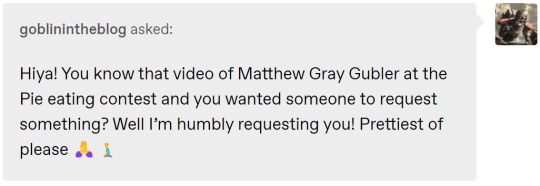


pairing: s9!spencer reid x fem!reader
genre: fluff, established relationship, SMUT
warnings: 18+ CONTENT; MINORS DO NOT INTERACT !! oral fem receiving, spencer reid is a munch, hair pulling, fingering
a/n: a promise is a promise !! based off of this post <3 i hope this lived up to expectations !! first time writing fem oral ha h a ha
wc: 1.1k

Honestly, if there’s one person Spencer can blame for the situation he is currently in, he blames himself. After all, he should have known that a ‘gathering’ at Rossi’s house that was planned by Penelope would only call for a lot of teasing, a lot of ‘get to know each other!’ games (despite the fact that he has worked with this same team for more than seven years. What else is there to know?), and a lot of alcohol. He didn’t quite realise that these games would be of the drinking variety. Alas, here he is, sitting on one of Rossi’s incredibly expensive leather couches and cringing at the horrid taste of whiskey.
The game they’re currently playing is an alcoholic’s rendition of ‘who is most likely to?’, involving a thick stack of cards with different topics while each member of the team took turns reading out. Whoever ended up with the most amount fingers pointed in their direction was forced to drink.
Spencer hates this game. He has drank from his cup a grand total of six times, and he is not getting any more used to the spicy-poison-equivalent in his hand.
“Alright, this is a good one,” Derek announces with a manic snigger. “Who here is most likely to be a munch?”
There is no hesitation in anyone’s answers, and all six fingers point into Spencer’s direction. His jaw drops at the betrayal, his head spinning from the sheer amount of shots he had to take but also what the hell is a munch?
“I don’t even know what that means!” He insists.
“Oh–” Penelope wears a half delighted half pitying expression at his words. “We really need to get you onto the internet more. Reddit is probably up your alley.”
“Even Rossi knows what it means,” Emily cackles, gesturing to Rossi who looks all too pleased. “Hotch was my second option though.”
Aaron shrugs, sipping at his drink. “Guilty.”
A chorus of laughs and shrieks erupt from the group, leaving Spencer even more confused. “What?”
“Don’t Google it,” JJ chimes in. “Seriously.”
Spencer nods, and although he knows that he should have taken the warning seriously, the curiosity was getting to him and he had no choice but to search it up as soon as he got home. He gets the usual answers– the etymology of the word, what it means in the Oxford Dictionary, the popularity of the word since the early 1800s, and he really doesn’t understand what the fuss is. Does the team think that he eats loudly? Or that he chews with his mouth open? His brows furrow at the unsightly thought.
His interest soon shifts to a different a different link, namely The Urban Dictionary. He blinks, clicking on the link without much thought and– oh. He does not get much sleep that night.
***
Your relationship with Spencer isn’t a secret. At least, it was never supposed to be classified as such. He is simply an incredibly private person that even his closest friends don’t know that you exist. It simply never popped up in conversation– or so he says.
The relationship isn’t necessarily new either. It’s nearing the one year mark and you have gotten to the point where the two of you have been more ‘experimental’ when it comes to sex. He finds it embarrassing. You find it unsurprising that he would. You find it even more surprising when he breaks a kiss halfway to lower you onto his bed, your head falling to one of his very expensive memory foam pillows.
“I want to try something,” he announces softly into your ear, squeezing gently at your waist and looping his fingers into his shorts. “Is that okay?”
“Yeah,” you breathe, body hot with anticipation as he pulls down your shorts. It’s only when he brings his face between your thighs do you realise what he intends to do. “Spence, you don’t have to–”
“I want to,” he repeats softly, his fingers running up and down the lacy fabric at your slit. “If you want me to stop, you can tell me.”
You shake your head immediately at that, your hands moving to his grip his shoulders. “No, I don’t want you to stop but– but Spence, this is the first time you’ve done this. It’s okay–”
“Let me do this for you,” he says, his breath ghosting against the sensitive skin of your thighs. “I’ve done my research.”
“What–”
You’re silenced as soon as he presses his lips to your cunt, only separated by your pretty lacy underwear. He groans quietly at the taste of your slick seeping through the fabric, and his hands hold onto your thighs to keep them parted. It’s so good, so good, but it just isn’t enough. He pushes the fabric to the side, watching the way it clings and sticks to your skin.
All it takes is one swipe of his tongue on your pretty clit for his brain to grow blank. The grip he has on your thighs grow firmer and his fingers dig in hard enough to leave little marks. His nose bumps against your clit while his tongue travels against your folds.
“You taste so fucking good,” he breathes against you, lapping at your dripping cunt. “Fuck, angel, you’re so beautiful.”
Then, he’s on you all over again. His lips wrap around your clit and he whines into you as he sucks at the bundle of nerves. Each one of his actions has your back lifting from the bed and your hands tugging at his curls, to which he responds with a quiet moan. Amidst the pleasure, your mind nags you to be gentle, and you loosen your grip despite it taking all of your self control.
“Do that again.” He says it as a demand, guiding your hands back into his hair. “Do it again, angel.”
His head is spinning and he craves for more of you, his tongue flattening against your clit over and over again. He brings his own fingers to brush against your entrance, coating them with your slick before slipping his middle finger inside. It’s only the first knuckle but it’s enough to have you squirming beneath him. He pushes further until it reaches all the way, and Spencer groans at the feeling of you tightening around him. He kisses your clit again at the same time he curls his finger inside you and it’s all too much.
“Spence–”
You gush around his finger and he licks and laps at your pussy like he needs it to breathe. His finger curls open and closed inside you while you rock your hips against his face, your grip on his hair tightening as each second of your high passes.
“So good,” Spencer moans, kissing your clit. “Taste so good. You can do one more, right, angel? Just one more, I promise.”

reblogs are always appreciated !!
tagging the people who commented on the original post: @mosaicbrokenherz @doigettokeepyou @goblinintheblog @cassioxpeiaxmgg @daddytenebra @lilliumrorum @matthew-gray-gubler-lover @lightreiding

#spencer reid x reader#spencer reid smut#spencer reid#spencer reid x reader smut#spencer reid fluff#nightingale ..#spencer reid x reader fluff#matthew gray gubler x reader#munch!spencer reid#criminal minds x reader#matthew gray gubler smut#matthew gray gubler x reader smut#criminal minds#criminal minds smut#criminal minds x reader smut#criminal minds fluff#criminal minds x reader fluff#matthew gray gubler#mgg x reader#mgg x reader smut#mgg smut#matthew gray gubler x reader fluff#matthew gray gubler fluff#matthew gray gray gubler
796 notes
·
View notes
Text

It’s been a few since I added some books. I was on vacation and then getting adjusted back to work.
Starting back up with one I’m currently reading,
“Radical Suburbs: Experimental Living on the Fringes of the American City” by Amanda Kolson Hurley
Are the suburbs really that white? Did you know that in the last few years, after DECADES of stagnation, American Cities suburbs have grown more diverse than the inner cities? Did you know that as of late most immigrants coming to this country skip the city all together for the suburbs?
Amanda Hurley tackles the history and out of date assumptions revolving around American Suburbs. So far it’s been a rather interesting read. Rather short if I’m being honest but packed full of information.
#tomework#book review#currently reading#book blog#nonfiction#radical suburbs#Amanda Hurley#experimental living#socioeconomic#urban planning#urban development#the suburbs#suburbia
0 notes
Text
2/?? Prometheus attempts to establish themes
(Previous) | (Index) | (Next)
Several minutes into Prometheus, we have had no dialog, and we are going to wish that it stayed that way.

This is by little fault of the actors themselves. They all put in solid work. Many of the problems come from the writing, and others from the mismatch between their characterization what we’d call “informed traits”: What the movie tells us we should know about these characters.

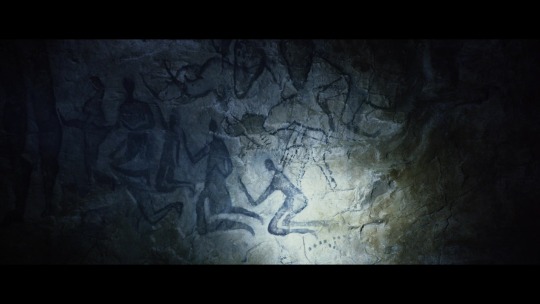
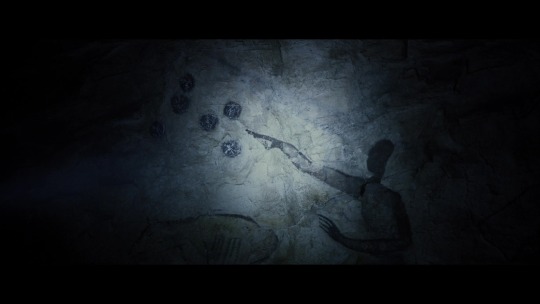
Elizabeth Shaw and Charlie Holloway are archaeologists. We see them with a dig team on the Isle of Skye, where they have just discovered their latest piece of evidence towards a radical theory. They have noticed something astounding that nobody else has dared to consider: evidence of alien contact with Earth, recorded in the art of disparate cultures from around the world. We, the audience, already know that they’re right.
And we, the audience, know that the History Channel has had kooks on it for ages, ranting about Ancient Aliens. We’ve all seen the meme guy.

Okay. Let's try to meet this movie where it wants to be, thematically. These are its first two scenes, it's still establishing its direction, and nothing openly egregious has happened yet. We will ignore nitpicky stuff, like the fact that this previously undiscovered dig site is right next to a well-known tourist spot on Skye with 400 reviews on Google Maps.
This movie is establishing an existential premise for its themes. It implies aliens had some hand in shaping not just our culture, but our evolution. The questions it invites at this time are equally existential: why would they do that? What was their purpose here? What was their purpose for us? Why did they stop contacting Earth?
Whether life has a purpose is one of the core debates of philosophy and religion. This movie is beginning with the premise that terrestrial life does have a purpose, implied by the deliberate sacrifice of a thinking being to shape it. This supposition could create a more focused exploration of one possibility, within its narrative space.
I think it fails to deliver on this. The writing specifically fails to deliver on this, which will become apparent once we have more dialog. But there is also an issue with the framing of this premise, which the movie ultimately does not manage to avoid. An issue of cultural context.
Because this is where I, as somebody with a background in history, start to brace. The idea of extraterrestrials visiting ancient peoples is a discredited mid-20th century theory, which stems from ignorance of the historical record, and assumption of ignorance and incapability of ancient peoples to achieve great things, particularly outside of the cultures placed in the prized pedigree of European civilization.

Such theorists look at the Great Pyramid of Giza and scoff at the idea that they it have been made without outside help, completely unaware of the century of more experimental pyramid-building that had preceded it, and the fact that we have written records that help us chart the progress of Egyptian mathematics for six hundred years prior to its construction.
They point to the Ramayana–likely written down around the same time that the Ancient Greeks were getting along just fine without aliens–and they say that the flying castles and chariots described in the text must’ve been aliens, who were mistaken for gods, and technological achievements such as rust-resistant iron must have been alien-made. Never mind that the period had a lively scholarly culture that was incorporating ideas from their Greek and Egyptian counterparts, and the people of the Indus Valley built well-planned metropolises with the world’s first known urban sanitation systems three thousand years before that.
They think the Moai of Rapanui, some of which were being erected while Shakespeare was writing his plays, were erected with the help of aliens. The actual answer, as usual, seems to be much more interesting: the Moai walked there:.
youtube
This is what ideas of ancient aliens are culturally tied to. You throw this into a movie, and even with the foreknowledge that they’re going to be proven right, I start out skeptical of these people from moment one. I was less likely to give them the benefit of the doubt, and less able to suspend my disbelief around them specifically. This will not get easier as we go.
Which is unfortunate, because most of the next scene is back to being phenomenal, and managed to bounce me back into going along with their premise.
...A side note as we close this out: Getting way too deep into the weeds here, but the art style of the cave paintings is worth mentioning. It appears to be a mashup of two famous cave’s painting styles: The animals are near-replicas of those famously seen in Chauvet (35,000 years old), and the humans and attendant dots are somewhat similar to Lascaux (17,000 years old), both caves in France. Here's an excellent little video from Tom Scott about the former, and the way that you can go see the cave paintings without endangering the site itself. There's a similar museum for Lascaux, shown below!
youtube
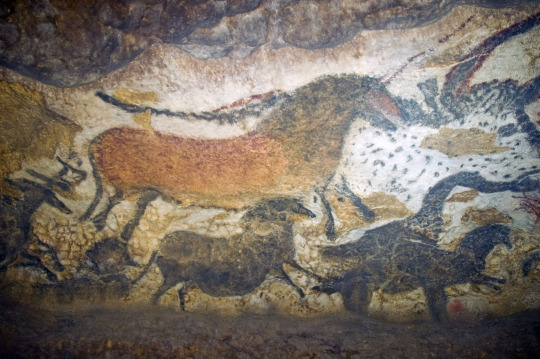
I say the human figures are somewhat similar to Lascaux, but I can’t find a match for the style anywhere. The closest I can find is from Tassili n’Ajjer in Algeria (6000 BC) or the Cave of Beasts in the Gilf Kebir mountains in Egypt (5000+ BC). This is because depictions of humanoid figures in european cave art are rare–ranging from a single bird-head figure in Lascaux, to the possible hoax at La Marche.
This produces an interesting implication, if we take the movie’s premise at face value. If humanoid figures were avoided as subjects for cave art for thousands of years, their inclusion here is especially significant. Perhaps indicating that the alien visitors instructed that some visual representation of this scene to be made, or did so themselves. Thus, it is slotted in amongst the pre-existing animal art, creating a culture clash.
…However, cave lions never made it as far north as Skye. Their known northern range tapped out at about London. While it’s certainly possible that people could’ve traveled that far during this period, local animals tend to be the focus of cave paintings. So we’re getting the visual sense that a French stone age painter was doing a residency at Skye. Amusing, but odd.
⛬
(Previous) | (Index) | (Next)
⛬
Citations for alt text ramblings:
1. https://www.isleofskye.com/skye-guide/top-ten-skye-walks/old-man-of-storr
2. https://en.wikipedia.org/wiki/Chariots_of_the_Gods%3F
3. https://www.usinflationcalculator.com/
4. https://kdp.amazon.com/en_US/royalty-calculator
5. https://search.worldcat.org/title/7625265
#Prometheus 2012#The Storr looks amazing#so does Chauvet 2#isn't it cool that we have physical recreations of art that's over 30000 years old?#So that we can experience some fraction of the life and works of people otherwise lost to us#without disturbing their legacy#also there's a movie I'm talking about in here somewhere#I guess I can thank the movie for getting me thinking about this
43 notes
·
View notes
Note
Hello!
I'm currently planning out a fic centering around an oc from kiri, and I was wondering if you could expand a little on the scenery of kiri? Maybe just idea's of how kirigakure looks on the inside, specific buildings that could be of importance inside the village, ect if thats alright with you.
omg a request fjsanag
Hi there nonnie! Of course I can do that! I love talking about the scenery of different places in Naruto and Kiri is one of my favorite places to explore! I'm also currently planning on posting about holidays and festive occasions in the big ninja villages, where Kiri is included as well. So make sure to stick around ;)
This is the third expansion of my current Kirigakure Worldbuilding Headcanons, which can be found here and here.
Kirigakure Worldbuilding III - The Scenery of Kirigakure
Rice fields around Kirigakure



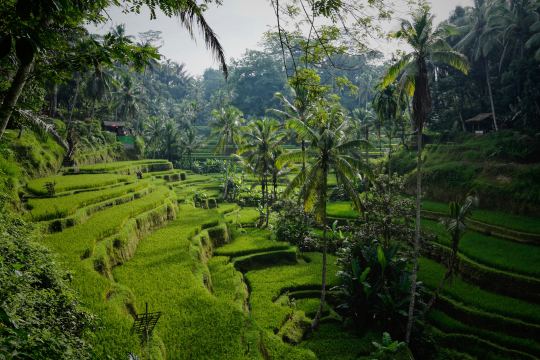
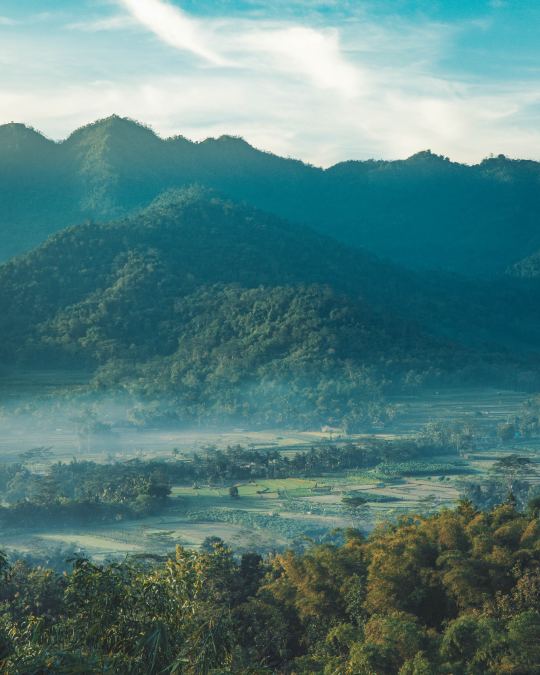

As previously established, rice is an important part in the local eating pyramid of Kirigakure. The population of the water country is very small and lives rather centralized, most water people are Kirigakure citizens. The few ones that aren't usually are rice farmers or fishermen.
Directly around the village
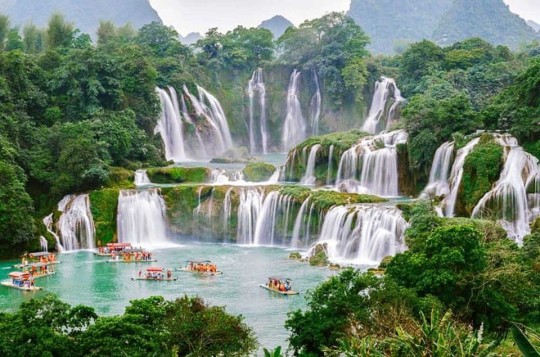
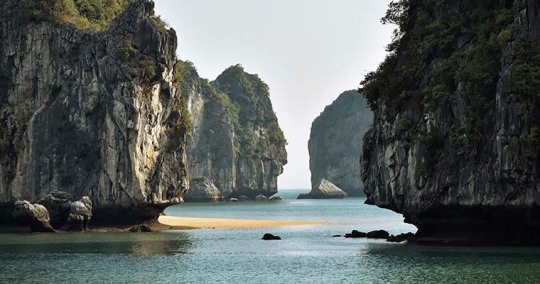
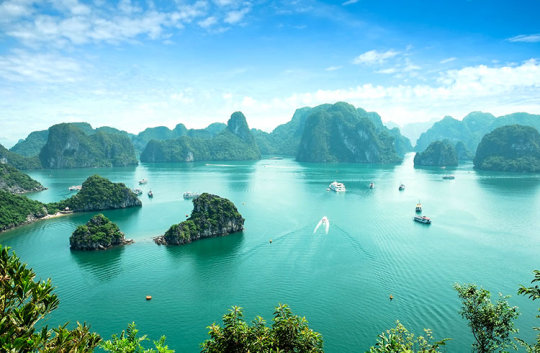



As we know, the village of Kirigakure itself is surrounded by mountains. However, there are also depictions of Kiri being a coastal city. This made me come to the conclusion that the landscape around Kiri probably looks similar to the coastline of vietnam.
Inside the village
Unfortunately, I haven't found any pictures resemmbling Kirigakure architecture. I even tried dabbling my toes into AI image generation, but the results were very bland and unsatisfying. Since the only canonical depiction of Kirigakure as a whole is the image below, we have a to use a little more imagination here. However, I got a little more inspiritation from imagines of the Kirigakure minecraft building project.
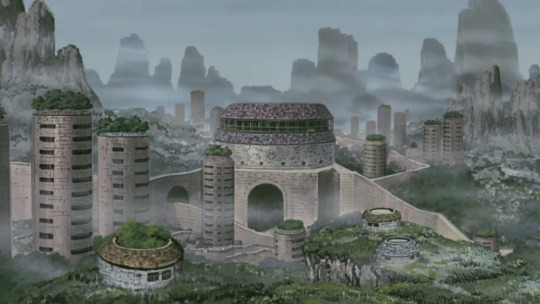
Buildings in Kirigakure
Kirigakure is criss crossed by rivers, so the urban planners of Kiri had to maneuver around that. Unlike Iwagakure, who can just erect buildings out of nothing due to their earth chakra affinity, Kirigakure's builds are carefully planned and constructed and involve a lot of bureaucracy.
The architecture of Kirigakure is compromised of large, cylindrical buildings which have vegetation growing on their roofs. This is a fantastic way to emulate the shape of the mountains surrounding the village, which makes it hard to spot, all hidden in the thick wades of fog. The residence of the mizukage is the widest and overall largest building of them all. It serves as both the home and the office of the mizukage, the Oi nin headquarters are also located in the same building.
Other important buildings of Kirigakure include the Kiri hospital, the Kiri academy and the Kiri waste management facility.
The Kiri hospital
As previously established, Kirigakure offers free healthcare for everybody, even lower castes. The kiri hospital is a tall, sky-scaper- like building which looks similar to the other buildings. Medic ninja are trained here, however their pay is very sparse. They are provided with housing and basic food rations and their salary is just enough to be able to afford eating out once a month. Members of lower castes often have to wait long waiting times to finally get an appointment with the only way of cutting it short being a 'voluntary' member of Kirigakure's experimental treatment program, where, as the name implies, experimental drugs and other therapies are tested.
The Kiri academy
As opposed to other villages, genin, chunin, jonin and anbu are all trained in the same building, which is the Kirigakure academy. Since the government has enrolled policies to encourage its citizens to eat and drink healthy, genin are handed out sauerkraut juice and lunch boxes for free, others are expected to pay.
The Kiri waste management facility
Kirigakure is a very clean village with a nationwide reclycling system. Inside the waste management facility, reusables are autoclaved and redelivered to the businesses that need them. Biodegragable waste is sorted by its biodegradation speed and then composted or used to produce natural gas. Due to its advances in scientific research, Kiri scientists have developed microorganisms that can slowly degrade many organic materials, including plastic. This is a highly controlled process, which is why the Kiri waste management facility is almost as well locked and protected as the Oi nin headquarters.
The Kiri waste management facility and the Kiri hospital both also serve as Kirigakure's main research facilities where biochemical, medical and general scientific research are conducted. Its advantages in research paired with the authoritarian nature of the goverment have proven to be an advantage in the face of catastrophes, such as endemic outbreaks of pathogens or natural desasters.
Aside from these buildings, there are other buildings important to the Kiri infrastructure, such as a thermal power plant on the outskirts of the village.
Other important places in Kirigakure



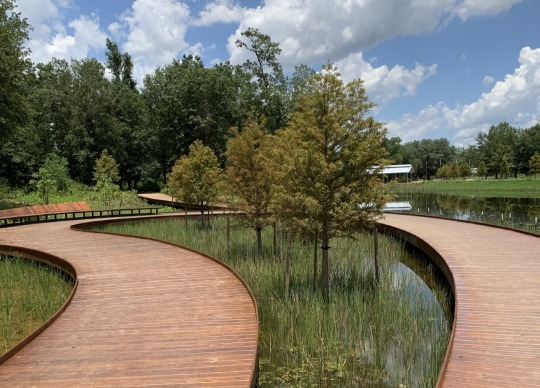

Big restaurants are a rarity in Kirigakure since most people can't really afford to eat out. Most of the time it's a small family owned business with a specialization in one dish or two. Cultural sites aren't found often either, since many ethnicities and cultures have been wiped out due to the ongoing political unrest in Kirigakure. The only remnants of clan culture in Kirigakure come from high ranking castes, such as the Hozuki and the Hoshigaki clan. The remaining places where people can meet up are Kiri's luscious parks and the public bathhouse. It is a place to meet and talk with all your friends, as Kiri bathhouses are traditionally unisex.

Dear anon, I really hope this is what you were looking for when making your request. As I said, finding fitting pictures really wasn't easy. If you have any more questions, feel free to make another request!
That's all, folks!
#naruto#naruto shippuden#naruto headcanons#naruto imagines#naruto scenarios#naruto fanfiction#fanfiction#kirigakure headcanon#kiri#naruto worldbuilding#worldbuilding#kisame headcanons#suigetsu headcanons#mei terumi#moodboard#kirigakure moodbooard#hidden mist village
34 notes
·
View notes
Text
Primary Personality Traits 📜✨
hi there! I’m in the process of making character profiles and in my search for some descriptions I stumbled upon this little gem. It’s a list of 638 character traits including positive, neutral, and negative traits you can use to describe your characters. I found it super helpful so I figured I’d link it here for my own record and other writers. you can also find the full list under the cut.
hope this helps, enjoy writeblr!

Positive Traits (234 = 37%)
Accessible
Active
Adaptable
Admirable
Adventurous
Agreeable
Alert
Allocentric
Amiable
Anticipative
Appreciative
Articulate
Aspiring
Athletic
Attractive
Balanced
Benevolent
Brilliant
Calm
Capable
Captivating
Caring
Challenging
Charismatic
Charming
Cheerful
Clean
Clear-headed
Clever
Colorful
Companionly
Compassionate
Conciliatory
Confident
Conscientious
Considerate
Constant
Contemplative
Cooperative
Courageous
Courteous
Creative
Cultured
Curious
Daring
Debonair
Decent
Decisive
Dedicated
Deep
Dignified
Directed
Disciplined
Discreet
Dramatic
Dutiful
Dynamic
Earnest
Ebullient
Educated
Efficient
Elegant
Eloquent
Empathetic
Energetic
Enthusiastic
Esthetic
Exciting
Extraordinary
Fair
Faithful
Farsighted
Felicific
Firm
Flexible
Focused
Forecful
Forgiving
Forthright
Freethinking
Friendly
Fun-loving
Gallant
Generous
Gentle
Genuine
Good-natured
Gracious
Hardworking
Healthy
Hearty
Helpful
Herioc
High-minded
Honest
Honorable
Humble
Humorous
Idealistic
Imaginative
Impressive
Incisive
Incorruptible
Independent
Individualistic
Innovative
Inoffensive
Insightful
Insouciant
Intelligent
Intuitive
Invulnerable
Kind
Knowledge
Leaderly
Leisurely
Liberal
Logical
Lovable
Loyal
Lyrical
Magnanimous
Many-sided
Masculine (Manly)
Mature
Methodical
Maticulous
Moderate
Modest
Multi-leveled
Neat
Nonauthoritarian
Objective
Observant
Open
Optimistic
Orderly
Organized
Original
Painstaking
Passionate
Patient
Patriotic
Peaceful
Perceptive
Perfectionist
Personable
Persuasive
Planful
Playful
Polished
Popular
Practical
Precise
Principled
Profound
Protean
Protective
Providential
Prudent
Punctual
Pruposeful
Rational
Realistic
Reflective
Relaxed
Reliable
Resourceful
Respectful
Responsible
Responsive
Reverential
Romantic
Rustic
Sage
Sane
Scholarly
Scrupulous
Secure
Selfless
Self-critical
Self-defacing
Self-denying
Self-reliant
Self-sufficent
Sensitive
Sentimental
Seraphic
Serious
Sexy
Sharing
Shrewd
Simple
Skillful
Sober
Sociable
Solid
Sophisticated
Spontaneous
Sporting
Stable
Steadfast
Steady
Stoic
Strong
Studious
Suave
Subtle
Sweet
Sympathetic
Systematic
Tasteful
Teacherly
Thorough
Tidy
Tolerant
Tractable
Trusting
Uncomplaining
Understanding
Undogmatic
Unfoolable
Upright
Urbane
Venturesome
Vivacious
Warm
Well-bred
Well-read
Well-rounded
Winning
Wise
Witty
Youthful
Neutral Traits (292 = 18%)
Absentminded
Aggressive
Ambitious
Amusing
Artful
Ascetic
Authoritarian
Big-thinking
Boyish
Breezy
Businesslike
Busy
Casual
Crebral
Chummy
Circumspect
Competitive
Complex
Confidential
Conservative
Contradictory
Crisp
Cute
Deceptive
Determined
Dominating
Dreamy
Driving
Droll
Dry
Earthy
Effeminate
Emotional
Enigmatic
Experimental
Familial
Folksy
Formal
Freewheeling
Frugal
Glamorous
Guileless
High-spirited
Huried
Hypnotic
Iconoclastic
Idiosyncratic
Impassive
Impersonal
Impressionable
Intense
Invisible
Irreligious
Irreverent
Maternal
Mellow
Modern
Moralistic
Mystical
Neutral
Noncommittal
Noncompetitive
Obedient
Old-fashined
Ordinary
Outspoken
Paternalistic
Physical
Placid
Political
Predictable
Preoccupied
Private
Progressive
Proud
Pure
Questioning
Quiet
Religious
Reserved
Restrained
Retiring
Sarcastic
Self-conscious
Sensual
Skeptical
Smooth
Soft
Solemn
Solitary
Stern
Stolid
Strict
Stubborn
Stylish
Subjective
Surprising
Soft
Tough
Unaggressive
Unambitious
Unceremonious
Unchanging
Undemanding
Unfathomable
Unhurried
Uninhibited
Unpatriotic
Unpredicatable
Unreligious
Unsentimental
Whimsical
Negative Traits (292 = 46%)
Abrasive
Abrupt
Agonizing
Aimless
Airy
Aloof
Amoral
Angry
Anxious
Apathetic
Arbitrary
Argumentative
Arrogantt
Artificial
Asocial
Assertive
Astigmatic
Barbaric
Bewildered
Bizarre
Bland
Blunt
Biosterous
Brittle
Brutal
Calculating
Callous
Cantakerous
Careless
Cautious
Charmless
Childish
Clumsy
Coarse
Cold
Colorless
Complacent
Complaintive
Compulsive
Conceited
Condemnatory
Conformist
Confused
Contemptible
Conventional
Cowardly
Crafty
Crass
Crazy
Criminal
Critical
Crude
Cruel
Cynical
Decadent
Deceitful
Delicate
Demanding
Dependent
Desperate
Destructive
Devious
Difficult
Dirty
Disconcerting
Discontented
Discouraging
Discourteous
Dishonest
Disloyal
Disobedient
Disorderly
Disorganized
Disputatious
Disrespectful
Disruptive
Dissolute
Dissonant
Distractible
Disturbing
Dogmatic
Domineering
Dull
Easily Discouraged
Egocentric
Enervated
Envious
Erratic
Escapist
Excitable
Expedient
Extravagant
Extreme
Faithless
False
Fanatical
Fanciful
Fatalistic
Fawning
Fearful
Fickle
Fiery
Fixed
Flamboyant
Foolish
Forgetful
Fraudulent
Frightening
Frivolous
Gloomy
Graceless
Grand
Greedy
Grim
Gullible
Hateful
Haughty
Hedonistic
Hesitant
Hidebound
High-handed
Hostile
Ignorant
Imitative
Impatient
Impractical
Imprudent
Impulsive
Inconsiderate
Incurious
Indecisive
Indulgent
Inert
Inhibited
Insecure
Insensitive
Insincere
Insulting
Intolerant
Irascible
Irrational
Irresponsible
Irritable
Lazy
Libidinous
Loquacious
Malicious
Mannered
Mannerless
Mawkish
Mealymouthed
Mechanical
Meddlesome
Melancholic
Meretricious
Messy
Miserable
Miserly
Misguided
Mistaken
Money-minded
Monstrous
Moody
Morbid
Muddle-headed
Naive
Narcissistic
Narrow
Narrow-minded
Natty
Negativistic
Neglectful
Neurotic
Nihilistic
Obnoxious
Obsessive
Obvious
Odd
Offhand
One-dimensional
One-sided
Opinionated
Opportunistic
Oppressed
Outrageous
Overimaginative
Paranoid
Passive
Pedantic
Perverse
Petty
Pharissical
Phlegmatic
Plodding
Pompous
Possessive
Power-hungry
Predatory
Prejudiced
Presumptuous
Pretentious
Prim
Procrastinating
Profligate
Provocative
Pugnacious
Puritanical
Quirky
Reactionary
Reactive
Regimental
Regretful
Repentant
Repressed
Resentful
Ridiculous
Rigid
Ritualistic
Rowdy
Ruined
Sadistic
Sanctimonious
Scheming
Scornful
Secretive
Sedentary
Selfish
Self-indulgent
Shallow
Shortsighted
Shy
Silly
Single-minded
Sloppy
Slow
Sly
Small-thinking
Softheaded
Sordid
Steely
Stiff
Strong-willed
Stupid
Submissive
Superficial
Superstitious
Suspicious
Tactless
Tasteless
Tense
Thievish
Thoughtless
Timid
Transparent
Treacherous
Trendy
Troublesome
Unappreciative
Uncaring
Uncharitable
Unconvincing
Uncooperative
Uncreative
Uncritical
Unctuous
Undisciplined
Unfriendly
Ungrateful
Unhealthy
Unimaginative
Unimpressive
Unlovable
Unpolished
Unprincipled
Unrealistic
Unreflective
Unreliable
Unrestrained
Unself-critical
Unstable
Vacuous
Vague
Venal
Venomous
Vindictive
Vulnerable
Weak
Weak-willed
Well-meaning
Willful
Wishful
Zany
#writeblr#writeblr community#writeblr resources#characterization#character descriptions#character traits#character creation#descriptions#personality traits#my honey.🍯
797 notes
·
View notes
Text
The city is where it’s at. Most of the human world lives in cities. Even so, it doesn’t feel like cities are necessarily made for their citizens. From low walkability to hostile architecture to prolonged development, the design isn’t very human. This isn’t even getting into how this impacts the environment and animals. This comes from bureaucracy-laden planning and design, being imparted from the top down. Approaching the creation of spaces for people without those people being involved leads to a focus on capital holders and what they want. If the conversation is between corporations/developers, municipalities, and citizens, citizens are the most important but least considered group in this conversation. That’s why we have shitty cities, rampant with inequity, unsustainability, and destitution.
That all probably sounds pretty bad. Thankfully, the citizen group has the power to come together and make changes with the resources they have available, creating a more liberatory, solarpunk future. This is where tactical urbanism comes in.
“Tactical Urbanism?”
Simply put, tactical urbanism is a grassroots-driven urban planning methodology that centers on DIY solutions and interventions. Instead of waiting for the city to act on a project, the community uses available resources to improve their community’s livability. This bottom-up orientation allows for iteration and experimentation to solve traffic issues, low numbers of green spaces, or general safety. These low-cost, DIY approaches can show interest in certain types of developments, encouraging long-lasting positive developments for the community.
Tactical urbanism can manifest as parklets, extending sidewalks and crosswalks, bike lanes, public art installations, seed bombing, outdoor seating, or more. It’s people imagining what they wish their city/community had and just going out and making it happen. These can be quick to implement, and even quicker to remove or modify as needed. This essentially allows for live pilots/prototypes of initiatives, where people can actually use the emergent infrastructure, encouraging longer-term solutions.
Tactical Urbanism x Solarpunk x Liberation
This methodology fits in well with the DIY ethos and grassroots-centric focus of solarpunk and liberatory movements. Solarpunk is all about imagining the futures that we want to see, full of equity, love, and harmony. Liberatory practices are the approaches that can bring the imagined into reality. As you can probably gather, tactical urbanism is a way to take action toward these goals, creating community-driven change. This allows for community resilience to be built and gives people a sense of ownership over the commons, creating a new world in the current one. It’s like a tiny revolution in the hearts and minds of those who participate.
With a tactical urbanism lens, a community could create community gardens or food forests on vacant/underutilized land. This space could allow for building relationships with each other and the land, grow collective self-sufficiencies, and inspire more change in the community. Not to mention the benefits this provides to the local food system.
How to Start Participating in Tactical Urbanism?
Participating in tactical urbanism can be as simple as identifying a problem in your local community and coming up with a creative solution. Here are some steps to get started:
Hopefully, after reading this you’re jazzed about the little changes that lead to big changes you can make in your own community. If you’re looking to start something, here is a very simple overview for you to think about:
Inspiration → Look for an issue that you could solve using tactical urbanism. Some examples could be a lack of sidewalks, poor access to food, or the myriad of other issues your area has. Figure out the one you’re interested in and start doing research. Find out of similar issues have been solved through tactical urbanism and try to understand what community members think and want as possible responses to the issue.
Ideation → Synthesize what you’ve learned into more concrete ideas on how to respond to the issue. Here you’ll ideate with the community and decide what directions to move forward in.
Implementation → Create a full plan for the project, including what will be needed (budget, resources, timelines etc). Get a team together and implement the project. Celebrate.
Postmortem → Track the success of the project as it continues to be out in the real world. Always gather feedback from the community and compile findings into digestible formats, so you can present them to people if necessary.
Tactical urbanism is cool because it gives us a powerful tool for creating more equitable and sustainable cities. By empowering communities to take action and make changes in their own neighborhoods, we can begin to build a better world, one DIY project at a time. While the challenges facing urban areas are significant, tactical urbanism offers a way forward that is accessible, inclusive, and empowering. You can literally start now. Identify an issue in your community, gather some friends, and begin creating the future you want to see. Together, we can build a more livable, equitable, and solarpunk world.
77 notes
·
View notes
Text
HWS Switzerland headcanons
Multilingual by default. Also speaks the langauge of his businesspartners fluently.
Speaks extra thick Schwyzerdütsch with Gilbert, Ludwig, and Roderich just because he can. Gradually elevates difficulty levels to Berndütsch if they seem to slowly understand the previous levels of Schwytzerdütsch
A lot of Norse countries get credit for surviving harsh winters but he's equally tough. Surviving in a mountainy region with drastic winters is tough work.
Survivalist to the max. MacGuyver's himself through any rural environment.
Good with animals, especially more "difficult" to handle farm animals, like goats, cows, and donkeys. Trains his shephearding dogs perfectly.
Doesn't like horses though. Not sturdy enough and too much maintenance.
Adores his wildlife, especially vultures. Usually he doesn't like talking more personally to people but will hold an entire lecture on vultures and their significance in the ecosystem when prompted.
Also trains avalanche-rescue dogs.
Crafty in many departments: Can make his own food (from wheat to bread, milking to tasty aged cheese, etc.), expert forager, knits comfiest socks, hats, and sweaters, excellent first aid skills, expert woodworker, understands the physics of technology in extreme weather conditions, knows how to handle animals (wild or domestic), can fix almost any machinery. For some reason believes that qualifies him to cut his own bangs.
A bit intense when organizing. He's always organized about every event: Winter, business, travel trips, party planning. But he gets irritated if others are lax in this deparment when they're trying to organize the same thing.
Likes the finer things in life. Everything he surrounds himself with is of good quality whereas not boisterous. It's all very tasteful.
Likes to eat well.
Still drives over the border to shop at the grocery stores of his neighbor countries because the prices are much lower. Still complains about the cheese quality though.
Can be surprisingly charming at first meetings. Treats prople with reserved politness, makes small, light hearted jokes. But he's extremely difficult to get close to on a personal level.
Even spontaneous meeting just too chat are already too familiar to him.
Not uninterested in others but enjoys being mostly by himself.
Actually can be very funny. It's mostly dry humor yet he has an unmatched timing.
When he doesn't laugh at anyone else's jokes it's not for not getitng them but because he purposefully wants to signal that he doesn't want to dignify that comment with a laugh.
Deadpan comments are politely formulated yet ice-cold.
Quiet interested in culture. Loves to go to art exhibits, museums, or watch movies. Even enjoys experimental stuff. Yet, if he doesn't like something he will tear it verbrally to shreds for having wasted his time.
Uses many food metaphors without him noticing.
In modern days he has fun creating hip-hop-tracks. Nobody but him likes that.
Although he enjoys the refinery of urban environments, when he gets overwhelmed he retreats into the mountains to do craftswork, tend animals, and generally avoid human contact.
Terrific at any sport related to winter and mountains. Has to ski well by necessity although his first attempts at snowboarding were hillariously clumsy. Equally passionate about hockey and figure skating.
Hiking and mountain climbing are his summer time passions. Very convinced by his climbing skills, so he died on several ocassions doing freestyle climbing. Stubbornly doesn't accept his failure though.
Many of his early deaths include death by avalanche, guessing what herb is edible or not, freezing to death, and getting in a wresting match with a billy goat once.
Interested in science as so far as it serves to better human living conditions in natural enviroments, or how to do things more practically. Loves riding the train to watch the panorama although not keen on Ludwig nerding out about trains.
If he had to choose, his favourite neighbour might be Francois (don't tell him that though).
Of course he's a pretenstious schmuck about his chocolatier skills. Belgium and him have silent rivalry about who's choclate gets more praise.
Never leaves the house without a Swiss army knife.
#HWS Switzerland#Hetalia headcanons#long post#text#Haven't decided on my fan-name for him. Anyhting but Bash...
13 notes
·
View notes
Text
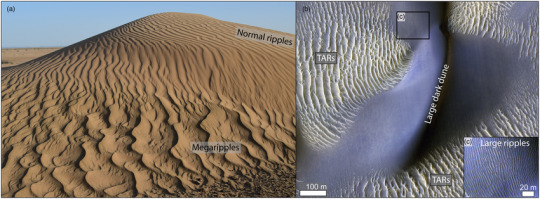


New theory that explains sand ripples on Mars and on Earth
Sand ripples are fascinating. They are symmetrical yet wind, which causes them, is very much not. Furthermore, they can be found on Mars and on Earth. They would be even more fascinating if the same effect found on Mars could be found here on Earth as well. What if one unified theory could explain their formation on two different planets of our solar system?
That is what Ben-Gurion University of the Negev physicist Prof. Hezi Yizhaq and Prof. Itzhak Katra and their colleagues from Denmark, Germany, Italy, China, and the US contend in a cover article published in Nature Geoscience (https://doi.org/10.1038/s41561-023-01348-3).
Sand ripples photographed on Mars by NASA's Curiosity rover in 2015 showed two distinct patterns – large ripples (meter scale) and a shorter "impact" ripples pattern (decimeter scale). The prevailing theory proposed since then argues that the smaller scale ripples are produced by the impact mechanism of the particles transported by the wind like normal ripples on Earth and the larger ripples form due to hydrodynamic instability like subaqueous ripples. Furthermore, it was believed that the physical conditions that produced them on Mars could not produce them on Earth.
However, Prof. Yizhaq and Prof. Katra have proven experimentally using Ben-Gurion University's wind tunnel and Aarhus University's Mars tunnel that such a phenomenon could exist on Earth – we just haven't noticed it yet because we didn't know we should be looking for it.
Imitating Martian sand was not easy because it's finer than sand here on Earth, explains Prof. Yizhaq, but the breakthrough occurred when they decided to try tiny glass balls to represent fine grains of sand.
Furthermore, the international research team has proposed a unified theoretical framework that would explain sand ripples on Mars and on Earth. At its most basic level, sand ripples on Mars caused by wind look like sand ripples on Earth caused by water.
"There is much more research, both fieldwork and experimentally, needed to prove our theory, but it is amazing to propose something so radically new in a field I have been studying for over 20 years. It is exciting to go out and try to find on Earth what can clearly be seen on Mars," says Prof. Yizhaq.
Prof. Yizhaq is a member of the Department of Solar Energy and Environmental Physics. Prof. Itzhak Katra is a member of the Department of Environmental, Geoinformatics and Urban Planning Sciences.
The research was supported by the Israel Science Foundation (Grant no. 1270/20), the German-Israel Foundation for Scientific Research and Development (GIF) (Grant no. 155-301.10/2018), the National Natural Science Foundation of China, Texas A&M Engineering Experiment Station, Europlanet grant no. 871149, and the Horizon 2020 Research and Innovation Program.
7 notes
·
View notes
Text
Test Subject: Venus Bio
Name: Test Subject Venus
Species: Daryan
Race: Redscale
Role: A Test Subject of Winterkill Works, and one of two whose powers didn’t backfire. Though she’s a sensible, caring person at her core, the stress of her current environment is steadily degrading her mental health. Considered a useful tool to Winterkill because of the abilities she gained.
Affiliation: Winterkill Works
Gender: Female
Age: 31
Height: 5’1
Appearance: Venus is a short woman with rather plain looks. She has dirty-blonde, neck-length hair with a somewhat coarse texture, kept in a straight bob that flares out toward the ends. Her eyes are a light, rosy, warm-hued shade of pink, and her features are sweet in a way that makes her look younger than she is. Nervousness often shows in her posture.
Personality: Venus is sensible, practical, and routine-oriented. Though generally calm, she’s easily frustrated by the antics of people around her (and known to have a bit of a short temper), especially when she knows she’ll have to deal with the mess that’s left behind. She’s gentle and compassionate, and despite claiming to dislike the task, often ends up taking care of those who need it, whether they ask her for help or not. Emotionally sensitive, she’s prone to taking on responsibilities and feelings of guilt that she rationally shouldn’t. Stress gets to her quickly, but she’s also resilient enough to get through that stress with little lasting damage. Modest, open-minded, and cooperative, she’s easy to be around and easy to trust.
Positive Traits: Venus does her best to be a decent person— though more in terms of personal values than any greater moral code. She’s naturally inclined to sympathy, which extends to treating people well even when they very much don’t deserve it. She’s level-headed and rational, patient with people and circumstances alike, and works for solutions, no matter how small. Caretaking comes easily to her (though she doesn’t always like that fact), and she’s generally as trustworthy, reliable, and easy to be around.
Negative Traits: One of Venus’s most harmful traits is her recurring tendency to take blame for things that she shouldn’t. Even when she knows better, she’s prone to second-guessing herself and finding reasons to worry, and once she’s started down that path, it’s hard to stop. She often takes on too much work or makes commitments that she knows she’ll regret, just because she can’t bring herself to say no. She can also be short-tempered and rather bossy, assuming she has to take control to fix a situation.
History: Before Winterkill Works, Venus worked in a management position in a fairly rural Daryan town. Though it was initially uneventful, the war’s end brought new chaos, in the form of social unrest, financial difficulties, and more. As part of a deal with the Guard’s science division, in exchange for funds directed to the town, Venus was supposedly transferred to a similar job within it— except, as she quickly found out, the real “job” involved serving as a test subject for Winterkill’s ambitious experiments.
Relationships: Venus can and does manage decent relationships with most of the people around her. She doesn’t always enjoy their company (she actively dislikes many of them, in fact), but her personality and willingness to help make her likable to most. Since she’s often forced to play nurse for many of the other Test Subjects, she’s gotten to know them all fairly well, though her closest friendship in Winterkill Works by far is with Bacchus.
Interests: Venus likes peaceful days, her region’s style of home cooking, and being able to work alone. She dislikes urban areas, unexpected changes in plans, and arguments. Since ending up at Winterkill Works, she’s ended up spending most of her “free time” checking in on the other test subjects.
WW Role: As one of the specially selected Test Subjects, Venus was given a particular experimental power. In her case, that power is a functionally “perfect” immune system that renders her immune to sickness and infection of nearly any variety. She’s one of two true successes among the Test Subjects, whose powers didn’t come with some kind of horrible cost.
Miscellaneous: Though she tries not to think about it, Venus can’t shake the fear that someday, her power will backfire like so many of the rest. Irrational as it is, she worries that the other test subjects resent her for coming out unscathed when they’ve suffered so greatly. Venus initially became friends with Bacchus because of their shared background in small-scale government, but by now, she considers Bacchus a close friend on a far more personal level. Though she claims to be annoyed by “nurse duty”, looking after the other test subjects keeps her mind well-occupied.
Connotative Description: A practical and pleasant person whose care for others is often fueled by an irrational sense of guilt. The “sane man” of the Test Subjects, in a sense, but troubled by her situation in more subtle ways.
9 notes
·
View notes
Text
Acclaimed Dutch architect Rem Koolhaas described it a masterpiece of experimental architecture. Singaporeans were drawn to it for its atmosphere and the abundance of cheap Thai food. For Thais living in Singapore, it was a home away from home.
Golden Mile Complex, also known as Little Thailand, was sold in 2021 to a consortium which will redevelop the building. As it has been gazetted as a conserved building by the Urban Redevelopment Authority, its physical structure is likely to be preserved. However, the same cannot be said for its unique character. Its tenants – a mix of inexpensive Thai eateries, seedy bars and tiny shops selling Thai perishables – were given until May 2023 to move out. Now that they have dispersed, they are unlikely to return.
As an era in the building’s history ends, it is timely to look back at its history, which goes back five decades.
Building Golden Mile Complex
Officially opened on 28 January 1972, Golden Mile Complex was an urban renewal project by the government to “redevelop and rejuvenate the slum-ridden areas in the Singapore city centre”.1 In the 1960s, the site was home to squatter settlements, small-time furniture and rattan makers, and the Kampong Glam Community Centre.2
In June 1967, then Minister for Law and National Development E.W. Barker announced that the area would be one of 14 urban redevelopment projects which would be transformed – resulting in modern skyscrapers, luxury apartments, hotels and shops – to give rise to a “new look Singapore”. These projects would involve the participation of private enterprises.3
Singapura Developments won the tender for the three-acre site that would eventually host Golden Mile Complex with a proposal for a building by the architecture firm Design Partnership (now known as DP Architects), which was then helmed by William S.W. Lim, Tay Kheng Soon and Koh Seow Chuan. The three men had convinced Singapura Developments to bid for the site in May 1969, offering the unusual proposition for a single building that would integrate shops, offices and apartments. Although the concept differed sharply from the government’s original proposal for luxury apartments on the plot, Lim, Tay and another architect, Gan Eng Oon, proved their design could work with an economic feasibility study that included precisely calculated land and sale prices.4
The all-in-one design of Golden Mile Complex marked a significant shift from how city planners in Singapore then traditionally segregated areas into different zones for “live, work, play”. In fact, it embodied Lim’s vision for “megastructures” that would contain all the functions of a city within a building, which he believed to be the future of Asian cities.
“We must reject outdated planning principles that seek to segregate man’s activities into arbitrary zones, no matter how attractive it may look in ordered squares on a land use map. We must reject arbitrary standards laid down that limit the intensive use of land,” said Lim and Tay as part of an essay for the Singapore Planning and Urban Research Group that was published in Asia Magazine in 1966.5 This vision was realised in Golden Mile Complex: a concrete megastructure that became one of the earliest mixed-use developments in Singapore and Asia.6
In January 1970, Singapura Developments began marketing the property and declared that “The Golden Mile Race Is On”. All 64 apartments were snapped up within a month, and most of the offices and shops were sold by the time building works commenced in May 1970.7
The building was originally named Woh Hup Complex, after the parent company of Singapura Developments. Rising 16 storeys, the edifice was designed in the Brutalist style popular in Europe and North America from the 1950s to the 1970s.8 It was constructed in a stepped terraced design held up by two end pillars that each adorned a star logo by Singapore’s leading graphic designer William Lee.9 Such a facade maximised waterfront views for the 64 apartments and maisonette penthouses spread across the topmost seven floors.
The next six floors housed 210 offices and studios to complete the tower that was seemingly pried apart in the middle. This sheltered a residential play deck facing Beach Road on the 10th storey while letting in natural light and ventilation into the office corridors and a three-storey podium. The latter comprised 360 shops that sat atop a basement carpark for 550 vehicles.
Completing the facilities was a four-storey residential car park at one end of the building that was topped with an open-air swimming pool overlooking the former Crawford Park. All these different functions were connected by corridors, including a “street” that ran through the podium of shops. The result was an interiorised environment designed to “encourage human interaction and intensify public life”.10
A Hub of Modernity
Woh Hup Complex was part of a pioneering wave of shopping centres to open in Singapore in the early 1970s, along with People’s Park Complex in Chinatown and Tanglin Shopping Centre and Specialists’ Centre in the Orchard Road area.
Like many of the complexes built then, Woh Hup Complex was also a strata-titled development. This form of property ownership was introduced by the government in 1968 to allow individual owners to have a share of a land. It allowed property developers to quickly recoup their investment by tapping on a pool of buyers, and also enabled individuals to participate in the on-going modernisation of Singapore.11
Woh Hup Complex offered shop lots in various sizes, starting from a 144-square-foot lot for just $16,500.12 The prices were lower compared to other shopping centres because the complex was at the city centre fringe. But its developer remained bullish about its prospects. “We offer easy parking, no frayed nerves while coming up here,” said T.M. Yong, a director at Singapura Developments. “Our shop owners will most probably be able to offer goods at lower prices.”13 The earliest tenants in the complex were an eclectic mix of shoe retailers, beauty salons, photo studios, furniture suppliers, travel agents, eateries, restaurants and nightclubs.14
As one of the first buildings to offer modern office spaces in Singapore, Woh Hup Complex attracted many businesses too. Singapura Developments and its parent company Woh Hup as well as Design Partnership set up offices in the building.15 The complex also became known for its many architecture and engineering firms, including OD Architects who were conceiving the masterplan for the National University of Singapore’s Kent Ridge campus, Cardew and Rider Engineers who were working with Design Partnership on Marina Square, and several engineering firms involved in the construction of Singapore’s up-and-coming Mass Rapid Transit network.16
But a decade after the complex opened, there were complaints of interrupted water supply, faulty air-conditioning and lifts, leaking roofs, rotting ceiling boards, rubbish piling up along the corridors, and broken or missing lights.17 These were reported after Woh Hup exited the property market and sold Singapura Developments along with its properties to City Developments in 1981.18 Woh Hup Complex was then renamed Golden Mile Complex.
The Rise of “Little Thailand”
By the mid-1980s, many of the building professionals had moved their offices elsewhere and Golden Mile Complex became better known as the haunt of foreign construction workers, specifically those from Thailand.
After work, particularly on Sundays and public holidays, homesick Thai workers thronged Golden Mile Complex to drink Singha beer, catch up on news back home by reading Thai newspapers, and listen to Thai music on cassette tapes. The draw for most was the various eateries selling Thai food at reasonable prices on the ground floor. Not only did these establishments serve food just like home, they served them on tables and chairs “scattered in front of food shops” or along the corridors and the concourse – just “[like] a street corner in Haadyai or Bangkok”.19
Golden Mile Complex was also the terminal for tour buses plying the Singapore-Haadyai route operated by travel agencies located in the complex and the neighbouring Golden Mile Tower. As the Thai clientele in the complex grew, it became referred to as “Little Bangkok” and “Little Thailand”.20 The Thai community injected new life into what was then a rapidly ageing Golden Mile Complex, and attracted even more shops to serve the community. A tailor in the complex reportedly expanded from one shop to seven to sell all things Thai, while a “100% genuine Thai style” disco named Pattaya opened in 1988 on the second floor.21 There was even a 50-seat “cinema” that screened kick-boxing specials and Thai features at $3 a ticket.22
In 1986, the Straits Times reported that Golden Mile Complex “would be a ghost town but for the office workers, who appear at lunch time, and the Thais, who have made it their haunt”. Dorothy, a secretary working in an architecture firm in the complex, told the Straits Times: “Before the Thais started coming here about four years ago, the place was very dead. Now, it’s sometimes so noisy that you get a headache.” Because fights would occasionally break out, she was not a fan of the place. “For Thai food, I’d rather go to Joo Chiat,” she added.23 Her sentiments were shared by many other Singaporeans who avoided Golden Mile Complex on Sundays.
As one shopowner explained: “Our Sunday business has been hit. Some customers stay away because of the Thai character of the place.” A food stall operator added: “The Thais linger for hours, drinking beer and eating their favourite beef noodles. Sometimes, they fight among themselves over a few drinks.”24
It did not help that migrant workers and the complex were often in the news for the wrong reasons. As part of the government’s massive crackdown on illegal migrants in March 1989, 370 suspected Thai undocumented workers at Golden Mile Complex were nabbed in a single operation.25
National Icon or National Disgrace?
In 1994, Rem Koolhaas visited Singapore and marvelled at its development in his seminal essay “Singapore Songlines”. He was particularly captivated by Golden Mile Complex and People’s Park Complex, which he praised as “‘masterpieces’ of experimental architecture/urbanism”.26 On his next visit to Singapore in 2005, Koolhaas said: “These buildings were not intended to be landmarks but became landmarks. Yesterday, I went to see all the buildings again, and they are absolutely stunning, radical and amazing.”27
While Koolhaas and many in the architecture fraternity saw Golden Mile Complex as the future, most Singaporeans regarded it as a relic of the past. By the 1990s, a slew of new shopping centres had sprung up near the complex, including Raffles City, Bugis Junction, Suntec City, Millenia Walk and Marina Square. Many felt Golden Mile Complex and other strata-title malls were simply no match for these single-owner developments that could plan a more attractive retail mix to woo shoppers.28 A 1996 article in the Straits Times assessed that Golden Mile Complex was unlikely to change because of its ownership structure and should simply “fill [the] low-end gap”.29
The disconnect between Golden Mile Complex’s celebrated architecture and its decline came to a head in 2006. During a parliamentary session on 6 March, then Nominated Member of Parliament Ivan Png called it a “vertical slum”. He was particularly irked by how each individual owner had added “extensions, zinc sheets, patched floors, glass, all without any regard for other owners and without any regard for national welfare”, resulting in “a terrible eyesore and a national disgrace”.
“The appearance of Golden Mile Complex appals me whenever I drive along Nicoll Highway. It must create a terrible impression on foreign visitors arriving from the airport. How can we be a world-class city in a garden? The Golden Mile Complex is just the most extreme of how a strata-title property can deteriorate,” he said.30
This came just after Golden Mile Complex was featured in Singapore 1:1 – City, a publication showcasing significant architecture and urban design in the city-state.31 “That’s a real joke!” said Png. “Can you imagine if that thing was standing on the Singapore River between OCBC Building and UOB Centre?” He added: “It just gives me goosebumps. It’s so close to the city, yet it’s so unlike Singapore – orderly, tidy, everything neat. It’ll drag us down.”32
Not everyone agreed with his criticism. Retiree Evelyn Ong, who moved into the complex in 2005, immediately booked her 11-storey apartment after seeing the breathtaking views. She said: “Once I stepped in and saw the view, I said book, book, must book.” She bought her 1,000-square-foot apartment for about $310,000, and spent about $70,000 on renovations to make it look like a holiday resort. “I think I’m very lucky. It’s so difficult to find such a nice view. Every day, I sit here (at my balcony) and I can see the beautiful lights at night.” She agreed that more could be done to spruce up the building though.33
The local architecture fraternity pushed back against Png’s comments. In August 2006, Calvin Low, a trained architect and journalist, kickstarted a monthly series on local architecture in the Straits Times and titled his first article “Golden Mile Still Shines”.
“The architectural thesis that GMC [Golden Mile Complex] represented was revolutionary – not just for Singapore but globally, too. It stood as a concrete realisation of the architects’ vision of a futuristic city-within-a-building that offered a whole, new integrated way of living in a modern, tropical, urban Asian context,” he wrote.34
In November the same year, a collective of architects, designers and artists known as FARM launched “Save the Modern Building Series”, a lineup of talks to raise awareness of the complex and other pioneering modern buildings such as Pearl Bank Apartments.35 In November 2007, the inaugural architecture festival, Singapore ArchiFest 07 – organised by the Singapore Institute of Architects to celebrate Singapore’s built environment – featured tours of the complex conducted by architecture students from the National University of Singapore.36
A Landmark Saved, a Community Lost
In August 2018, news broke that more than 80 percent of the owners of units in the complex had agreed to put the building up for an en bloc sale at $800 million. This came hot on the heels of the sale of another modernist icon, Pearl Bank Apartments,37 just six months earlier. Heritage and architectural experts were dismayed at the news. “It will be a tragedy and a great loss to Singapore if the en-bloc sale results in the demolition and redevelopment of such an important urban landmark with such high architectural and social significance,” said heritage conservation expert Ho Weng Hin.38
Although architects and academics petitioned for Golden Mile Complex to be conserved, residents were in two minds about it. The complex’s long-time residents confessed they could no longer keep up with the building’s maintenance needs. “The problem is that it’s an old building, and when it rains, the water seeps through some of the walls. The building has water-proofing issues,” said Ponno Kalastree, who had lived and worked there since 1989. He was among those who had voted for the sale and was planning to downgrade to a Housing and Development Board flat, but admitted that he would miss the place.39
To the surprise of many, the Urban Redevelopment Authority (URA) told the Business Times in October 2018 that they have “assessed the building to have heritage value, and is in the process of engaging the stakeholders to explore options to facilitate conservation”. “Modern architecture, dating from our recent past, is a significant aspect of our built heritage, and we have selectively conserved a number of such buildings. Where there is strong support and merits for conservation, we will work with the relevant stakeholders to facilitate the process,” said the URA. This meant that the existing building could be retained while a new block would be added next to it.40
The tender closed in January the following year without any offer, and a second tender launched just two months later with the same terms and price tag of $800 million suffered the same fate.41
Almost one year after the two failed collective sales, the URA announced in October 2020 that it was officially proposing Golden Mile Complex to be conserved in light of its historical and architectural significance.42 When it was gazetted a year later in October 2021, Golden Mile Complex became the “first modern, large-scale strata-titled development to be conserved in Singapore”.43
The owners relaunched an en bloc sale in December that year at the same price of $800 million.44 This time, the sale was successful and the complex was sold in May 2022 to a consortium comprising Far East Organization, Sino Land and Perennial Holdings. Although their bid was $100 million lower than the reserve price, the owners agreed to the sale within “a record time of 15 days”.45
At the point of publishing this essay, the new owners have yet to reveal how they plan to redevelop Golden Mile Complex, though it is unlikely that any of the former tenants will return. The battle to conserve Golden Mile Complex has, ironically, cost the community who kept it alive when others moved on to swankier new buildings. But all, however, is not lost. The redevelopment of Golden Mile Complex could serve as a model for how other similar buildings in Singapore can be conserved and enjoy a new lease of life for the future.
9 notes
·
View notes
Text
The Danse Mechabre: White Elephant
AAR #01
Ran the first session in what is hopefully going to be a full Lancer campaign over the weekend. Gonna be posting these after-action reports from the GM perspective in case it's useful to anyone (and it turns out there are a couple of things I need to make sure I remember). No spoilers because at least half of the players are on the tumbles (eye see you).
Characters (LL 0):
Raiju (Hacker/Ace/Centimane) - GMS Everest - Delta
Sunshine (Grease Monkey/Technophile/Leader) - GMS Everest - Exchange of Affection
Rook (Walking Armory/Stormbringer/Brutal) - GMS Everest - Not Fun By Myself
Daylight (Technophile/Crack Shot/Infiltrator) - GMS Everest - Hits Different
Magpie (Hacker/Technophile/Centimane) - GMS Everest - General Protection Fault
You will notice right away that there are three - count 'em, three -characters with the Technophile talent. That means there are three bonus NHPs in the party. And the first thing I neglected to do is prompt for more interactions with the bonus NHPs. The only one that got characterization in this session was Molotov, Sunshine's little buddy.The reason I didn't prompt for more interaction is mostly because this group is used to 2.5-3 hour sessions and I am trying to hit one combat per session, which does not leave a lot of time for roleplay outside of combat. The schedule will need to be adjusted somewhat.
So in the year 4570u the PCs depart as crewmembers (and one stowaway) from the secret KRAKEN facility on the highly experimental blinkship Eye of the Tiger. The crew of the Eye of the Tiger had secretly been replaced with revolutionaries, planning to use its blink carver to quickly head towards the core worlds and help overthrow Union's Second Committee. They go into stasis, trigger the ship's blink carver and wake up to a variety of alarms blaring. It eventually turns out the year is now 5016u and the blink carver may have moved them in space as well as time. Or something. They fix up the ship a little and realize that they're near a planet that is putting out a distress call. When they also get the opposing force's broadcast about returning the planet to 'traditional Cradle values' they decide the situation requires mechanized intervention. Important note: I'm very happy with my players for not immediately deciding they need to intervene on the side of the people putting out the distress call and that maybe they need more information before getting stuck in. Keep hold of that instinct, just because you didn't need it this time doesn't mean you won't in the future.
So while the Eye of the Tiger engages the enemy fleet in orbit, the lancers drop right in to protect an urban area.
Combat 1.1: We get to be the Cavalry for Once
Sitrep: Control
OPFOR:
Pyro x2
Priest Vehicle x2
Hive x2
Grunt Breacher Vehicle x6
Outcome: PC victory, 11 - 8
No PC structure or stress damage, though Hits Different and Not Fun By Myself both used a Repair. The only mech to not get hit was Delta, which secured the lower left control zone and blasted away with its howitzer (whoever put the howitzer on the default Hacker loadout in COMP/CON is a real joker).
Here's the aftermath of the battle after I invoked the mercy rule when it became clear the NPCs couldn't take enough control zones some time around the middle of the last round (not pictured: the Hives' Razor Swarms that were still in 3/4 control zones).

(Tokens by Retrograde Minis (on the basic blank 1-hex tokens that come with Lancer so they show up well), map by Interpoint Station's pixel art assets, they released their new mapmaking tool like the day before we played. VTT is Roll20)
Most of the civilians had already been evacuated from the area with two exceptions: the blue building just above the lower left control zone (some kind of cultural building maybe, there were a lot of civilians around it), and the orange building to the left of the lower right control zone (an IPS-N showroom/liaison office). Those were both intact at the end of the combat, which will be relevant next session.
The enemy comp is very short-ranged which ended up working because the PCs had to get at them to get into their control zones. It also features a lot of burn which I ended up not using correctly (see below). I maybe went a bit hard on Strikers with that many Breachers, but I knew it would be fine because Breachers can only hit something once in a blue moon (Hits Different was the only one to get tagged by a Breacher shotgun). A lot of vehicles because I like combined arms in my mecha (I think I get this from my exposure to Battletech). No optionals on any of the enemies to reduce cognitive load on me, and even then there was plenty I forgot (see below).
I was worried about cover and LoS going into this because it doesn't feel like the Lancer rules have enough detail on that but it was easy enough to adjudicate in practice. Also shout out to one of the best rules in Lancer: the PC that went last nominates the PC to go next. That helped speed things up a lot.
Overall for a first combat with 5 PCs, getting through it in ~2.5 hours is pretty impressive! HOWEVER:
Things I Definitely Forgot About:
Tech attacks ignore cover!
Engagement gives +1 diff on ranged attacks!
Pyros deal double burn to anyone who already has burn!
Pyros can put out their FIREBREAK shield at the end of each of their turns!
Breacher's shotguns have a threat of 3!
All the PC talents!
Thankfully this can kind of be written off in fiction as the OPFOR being kind of bozos and the PCs not being fully familiar with their mechs (maybe some residual grogginess from stasis and the fact that mech warfare was still pretty new to them).
So definitely some things to keep in mind for next time - I'll have to come up with a format of NPC stat blocks that works for me because just using their stats in the core book clearly means some things get overlooked.
Next Time: Straight into the Wall?
INDULGE ME:
Campaign notebook is a Maruman Mnemosyne N195A, 7mm lined. A month ago I swore I would only use binders for campaigns going forward but Lancer seems constrained enough (note I did not say 'on rails') that I can get away with not doing that (as opposed to, say, a hexcrawling sandbox) that I can get away with it. Plus this notebook was only holding a half-done campaign idea that is unlikely to see the light of day so I figured I'd use the rest of the pages up. I've found the paper is very good at taking fountain pen ink, though I'm not using a fountain pen for these notes. I've settled on a Zebra Sarasa Clip 0.5mm gel pen as working best, and I do like that pen (it's what I used to finish out my #Dungeon23 notes).
6 notes
·
View notes
Photo

100 cities participating in EU Mission for climate-neutral and smart cities by 2030
The Commission announced the 100 EU cities that will participate in the EU Mission for 100 climate-neutral and smart cities by 2030, the so-called Cities Mission. The 100 cities come from all 27 Member States, with 12 additional cities coming from countries associated or with the potential of being associated to Horizon Europe, the EU's research and innovation programme (2021-2027).
Our urban areas are home to 75% of EU citizens. Globally, urban areas consume over 65% of the world's energy, accounting for more than 70% of CO2 emissions. It is therefore important that cities act as experimentation and innovation ecosystems to help all others in their transition to become climate-neutral by 2050.
Ursula von der Leyen, President of the Commission, said: “The green transition is making its way all over Europe right now. But there's always a need for trailblazers, who set themselves even higher goals. These cities are showing us the way to a healthier future. We will support them on this! Let's begin the work today.”
The Cities Mission will receive €360 million of Horizon Europe funding covering the period 2022-23, to start the innovation paths towards climate neutrality by 2030. The research and innovation actions will address clean mobility, energy efficiency and green urban planning, and offer the possibility to build joint initiatives and ramp up collaborations in synergies with other EU programmes.
Benefits for cities include tailor-made advice and assistance from a dedicated Mission Platform run by NetZeroCities, additional funding and financing opportunities and the possibility to join large innovation actions and pilot projects. The Mission also provides networking opportunities, exchange of best practices between cities and support to engage citizens in the mission.
Next Steps
The Commission will invite the 100 selected cities to develop Climate City Contracts, which will include an overall plan for climate neutrality across all sectors such as energy, buildings, waste management and transport, together with related investment plans. This process will involve citizens, research organisations and the private sector. The clear and visible commitments made by the cities in the Climate City Contracts will enable them to engage with the EU, national and regional authorities – and most importantly with their own citizens to deliver on this ambitious objective.
Moreover, in light of the overwhelming interest from 377 cities to join the mission, the Commission is also putting in place support for cities that were not selected, including support through the Mission Platform and funding opportunities under the Cities Mission Work Programme of Horizon Europe.
Members of the College said:
Executive Vice-President Frans Timmermans, for the European Green Deal, said: “Cities are at the forefront of the fight against the climate crisis. Whether it's greening urban spaces, tackling air pollution, reducing energy consumption in buildings, or advancing clean mobility solutions: cities are often the hub of the changes Europe needs to succeed in our transition to climate neutrality. My congratulations to the cities selected today, I look forward to the solutions you will develop to guide your inhabitants and businesses towards a greener future.”
Executive Vice-President Margrethe Vestager, for A Europe Fit for the Digital Age, said: “We need to speed up Europe's transition to climate neutrality, to end our reliance on fossil fuels, and to deliver benefits such as cleaner air and lower energy bills for our citizens. It is great that so many cities will participate. We can support their ambition with our EU research and innovation budget. The Cities Mission has the potential to make a major contribution to our Green Deal and for Europe to become a climate neutral continent by 2050.”
Mariya Gabriel, Commissioner for Innovation, Research, Culture, Education and Youth, said: “Horizon Europe Missions have a great potential to deliver the European Green Deal objectives, including European energy security. The selected cities represent a first step covering a wide geographical footprint. We want that concrete benefits reach all our regions and citizens, through innovation, empowering large and small cities with different levels of experience and capacities. I encourage all cities to reach out and work with all stakeholders, including of course their citizens, to achieve together our ambitious goals.”
Adina Vălean, Commissioner for transport, said: “In their quest to become smart and climate-neutral by 2030, the 100 EU cities announced today will be natural “test beds” for innovative integrated solutions to many of the issues facing our citizens today, including urban mobility. Drawing on our New Urban Mobility Framework, they have the tools to making interurban and urban mobility healthy and sustainable, for instance by doubling high-speed rail traffic and developing extra cycling infrastructure over the next 10 years, investing in safe bike lanes, and ensuring connectivity with rural and suburban areas so that commuters are given sustainable mobility options. I am sure they will succeed, and I encourage other cities across Europe to follow their lead.”
Virginijus Sinkevičius, Commissioner for Environment, Oceans and Fisheries said: “The Mission for climate-neutral and smart cities will help us deliver our environmental commitments on zero pollution, biodiversity and circular economy. Many of the selected cities have already shown their environmental credentials in our Green Capital, Green Leaf and Green City Accord initiatives by tackling air, noise and waste issues. These cities' ambitions for climate and innovation, as well as the Mission's wider research funding, will help make urban living greener, cleaner and healthier for European citizens.”
Background
Cities were invited to express their interest to become part of the Mission in November 2021. The call closed on 31 January 2022. In a first step, independent experts evaluated each expression of interest. In a second step, the Commission applied additional criteria to ensure a geographical balance and a diverse group of cities in terms of size, impact and innovative ideas. Overall, 377 cities applied to be part of the cities mission. The 100 EU Cities chosen today represent 12% of the EU population.
The Commission launched the Mission for 100 climate-neutral and smart cities by 2030 in September 2021 with the adoption of a Communication on EU missions. This following the approval of the missions' individual implementation plans in summer 2021. As well as the Cities Mission, there are four other EU missions covering global challenges in the areas of adaptation to climate change, restoring our ocean and waters, healthy soils and cancer. A dedicated Work Programme for Horizon Europe Missions was published on 15 December 2021.
Missions are a novelty of Horizon Europe and support Commission priorities, such as the European Green Deal, Europe fit for the Digital Age, Europe's Beating Cancer Plan, An economy that works for people and the New European Bauhaus. For instance, Mission Climate is already a concrete element of the new Climate Adaptation Strategy, Mission Cancer of Europe's Beating Cancer Plan and the Mission Soil is a flagship initiative of the Long-term Vision for the EU's Rural Areas.
91 notes
·
View notes
Text

updated design for machine(i liked that design of him in the leather jacket so much i decided to incorporate it in his main look. a profile for him is also under the cut.
"The Machine"
Real Name: Alejandro Ferro
Age: 32 years old
Birthday: June 2nd 1947
Occupation: Soldier
From: Nicaragua, but raised on Xoari(home planet of the aliens that kidnapped him, the khirens)
Family: Eduardo Ferro(father), Sofía Ferro(mother), unnamed siblings born since he was kidnapped
Friends: Mark, Vivian
Love Interest: Julie
Hobbies and Interests: Mechanics, video games, listening to music, movies, TV shows
Likes: Repairing things, Earth's technology(it's primitive but he's okay with that), learning about Earth, having friends, movies and TV in general(he just likes absorbing Earth media and doesn't have particular preferences)
Dislikes: Not knowing much about Earth or his real family, being shunned and alone, the khiren, rain
Rick's new version, he's a cyborg. Kidnapped as a baby by aliens from his home in rural Nicaragua(can't go anywhere urban, the aliens would be easily spotted), he grew up being used as an experiment, said experimentation planned to use him as a living weapon, hence his appearance. Once he discovered where he's from, he fled to Earth and hid as a recluse ever since. Only recently has he had friends and been shown love and kindness.
Personality
Having been only valued for his strength, Machine believes the love and approval of others is conditional, and that the only way he can have both is by being strong. He tries to win Julie's affections through displays of strength, and while she's impressed, it's not making her love him, and he doesn't understand why. He thinks he's doing something wrong, and he berates himself for it. Machine only understands that he doesn't need to be strong, when he does a kind act for Julie(undecided yet), and realises that kindness is part of love. It helps him realise how awful his upbringing was.
He's lived his whole life defined by the name "Machine" and being a super soldier, and when he comes to Earth, basically has an identity crisis. He was someone else on Earth once, but he doesn't know his real name, where he's truly from and he's disconnected from his humanity, not knowing what it means to be human. Since he's not a super soldier anymore, he's not sure what a "normal human life" looks like, but he tries to learn. It's awkward, silly and he unintentionally does illegal things like theft(he stole the clothes he wears because he doesn't know what currency is), but he's doing his best. Being friends with Julie, Mark and Vivian, and his romantic feelings for Julie, help him to connect with his humanity. Initially he thinks his robotic parts are bad, he rejects them because he feels they disconnect him from his humanity, but learns to accept them and that they don't make him any less human.
He has a kind heart despite it all, and is protective and caring of others. Machine has a strong sense of justice, and after fighting his whole life for a cause he was oblivious to, he makes sure he knows exactly why he's fighting. Having not been raised on Earth, he's also naive and oblivious to things on Earth, and does not understand things like social cues and phrases.
Despite his naivete and awkwardness, Machine is not someone to be messed with, and when angered, becomes very fierce, and will not hesitate to unleash the full extent of his strength and powers.
Background
Machine was born in a rural village in Nicaragua in 1947. He spent little time with his parents before the khirens raided his village and kidnapped him, with the intention of raising him to be a super soldier for their army.
Machine's life being raised as a super soldier was filled with abuse and general hardship. Only his fighting skills were valued and his flesh would be replaced and fused with robotic parts when he failed. His own wants and needs were never important. He never knew love, compassion or kindness, at least anything unconditional, and was a loner, not really interacting much with the other super soldiers as he wasn't a social type, and friendships weren't encouraged. The super soldiers in general were different species, all with their own needs, and Machine dealt with his human needs and what he can eat not being fully understood, and once they were understood to a degree, he was made to just have the bare minimum so he could survive. His robotic parts even had the effect of making him more resilient, so he didn't need to meet the exact same needs as other humans(such as not needing as many hours of sleep). He was also known by just a series of numbers, “Machine” is something he named himself.
He was often made to fight the other soldiers to train his skills and become stronger, and longed for the approval of his superiors so he wouldn't be seen as weak. Thanks to his training, he eventually became one of their strongest soldiers. Machine was sent out into battles, never knowing the extent to the conflicts he was participating in and his humanity shining through in his refusal to harm innocents.
His life changes when he discovers that he was taken from his parents as a baby, and that he comes from Earth. This motivates him to leave and find where he belongs, but because he's just one of many soldiers, it's not noticed or cared about that he's gone. Machine makes his way to Earth, but discovers how different he looks from other humans with his cyborg appearance, and he hides away in his ship while other humans treat him as an urban legend and come looking for him.
Then Julie comes around and is the first person to treat Machine as an actual person, not a soldier, not a weapon, not an urban legend, but another person just like her. Thanks to her, he also meets Mark and Vivian and all three of them help him integrate with Earth and his humanity. All the while, Machine slowly falls in love with Julie. Being on Earth away from life as a super soldier has also allowed Machine to really explore himself send what he likes and dislikes.
Abilities
Spider-like appendages: From his back, Machine can bring out these, and they can be used as both weapons and to attach and climb onto things.
Laser Eye: Machine's robotic eye can shoot lasers.
Scanning: His robotic eye can also scan things.
Flight
Enhanced Strength
Enhanced Speed
Enhanced Stamina
Agility
Skills
Mechanical Knowledge: As a cyborg, Machine has had to understand his robotic parts. If need be, he can easily fix them. He's recently found that he likes mechanics in general and has taken to repairing other things.
Fighting Skills: Being raised as a weapon and super soldier, Machine is very skilled at fighting.
Flight Skills: Machine can easily fly around in spaceships.
Other Things
His surname “Ferro” is a Spanish and Italian surname that was chosen because it means iron(to connect with Machine's whole cyborg thing). The name is derived from a person who worked with iron in general.
His real name, Alejandro, is the Spanish version of “Alexander”, meaning “defending men”.
Ideas
Pyri wants to use Machine as a weapon, so when he arrives on Embara, she plans to turn him against humanity so he will conquer Earth with her. But it doesn't work, he has become attached during his time on Earth and additionally has Julie, Mark and Vivian. She tries to turn him against them, but he doesn't fall for it, she tries to kill them and he protects them. Pyri decides that Machine has to be controlled, so a device is placed on him that makes him under her control. With this, she tries to get him to kill Julie, Mark and Vivian but Julie gets through to Machine and destroys the device, freeing him. When he had fought them too, he was restrained, because the real him was still in there and would never want to kill them. When Pyri sees she can't control him, she turns against him, leading to the final fight between Pyri and Machine.
During his time on Embara, Machine also learns of the khiren's ideals of conquest, and that they, and by extension he, were fighting against the fyralogins to defeat them and take over. He is horrified by this, and feels immense guilt, but Julie, Mark and Vivian, while shocked, don't hold it against him. He was kidnapped as a baby, and grew up being forced to be a weapon and soldier for the khirens, ignorant of their intentions, he never had any agency, any choice. This helps Machine and is an influencing factor in defeating Pyri, besides the obvious. When faced with the option to kill her, he doesn't. Machine wants to end the cycle of violence and believes killing her would achieve nothing. Instead Pyri is left to rot in jail while her heir takes over and agrees to end the empire once and for all. Machine also assists said heir in learning about the khiren and their technology to take them down for good.
When Machine finds his family again, he is told his real name: Alejandro Ferro. This finally cements his arc of finding his identity and connecting with his humanity, and that he is his own person with his own agency. In the end, he brings his family out of Nicaragua because of the civil war at the time, and they live in the same city as the group, and he moves in with Julie. He finally achieved his goal of peace and happiness, and is reunited with his family.
Machine's arc is about discovery, reclaiming, agency and choice. He is initially just viewed as a weapon and soldier, and one of many. On Earth he connects with his humanity, and for the first time, is treated like a person over a weapon(a reason why his relationship with Julie is so important, she's the first person to see him as a person and treat him as such). But on Embara, Pyri is trying to take his agency and choice away and sees him as a weapon, just like the khirens. She briefly succeeds, but Julie gets through to Machine in the end.
He also views his cybernetic parts negatively initially, because they are what cause others to see him as a weapon, and what other humans used to ostracise him. But in the end, he accepts them and uses them for good, to save humanity, making his own choices in the end. Machine takes back his agency and choice away from everyone who tried to strip it away from him.
His arc concludes with him finding his family and discovering his real name of Alejandro Ferro, a name which he takes on.
2 notes
·
View notes
Text
FADING GLORY: ON THE TRAIL OF JACK MORRISON
Olympia Shaw | July 6, 2015

I remember the day Jack Morrison died. It was the day the world lost a hero.
Like other members of the so-called "Overwatch Generation," I spent my childhood looking up to Morrison. He taught me that heroes were real. He made me believe that even I could be one. When he died under mysterious circumstances six years ago, I felt as if a part of my childhood died with him.
The details about his death have always remained few and far between, a strange fact, given that he was such a public figure. Maybe that's why after all this time, I find myself looking back at Morrison's life and asking the big question: what really happened to the man who defined my generation?
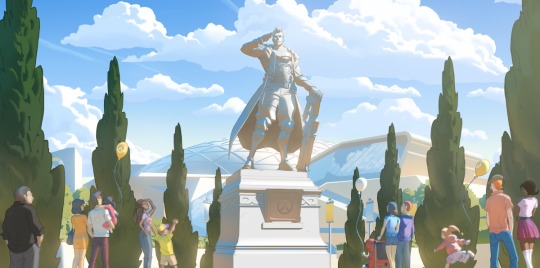
Traveling through rural Indiana, I find it easy to forget that a monumental figure like Jack Morrison came from such a tranquil, time-lost place. A sea of green and gold cornstalks stretches from horizon to horizon. There is no wind, no sound save the buzz of a few lonely insects. On the rare occasions when I cross paths with other living souls, they describe young Morrison in different ways. He was a rambunctious youth. A humble, salt-of-the-earth farmer's son. But these people all agree on one thing: Morrison was never destined to live out his days in the land of rolling plains and deep blue skies.
At eighteen, Morrison packed his bags and joined the military. He had planned to serve a brief stint in the armed forces and then return home to the family farm, but his work ethic and courage caught the eye of the military brass. Before long, he earned a coveted position in the government's controversial and still-classified (but widely acknowledged) "soldier enhancement program." Military scientists shaped Morrison and other inductees into the perfect soldiers, blessed with superhuman speed, strength, and agility.
Morrison and his fellow augmented soldiers would soon put their abilities to use with the advent of the Omnic Crisis. Across the globe, the omniums went rogue and churned out legions of militarized robots. The world reeled at the appearance of this new enemy. The omniums and their robot populations had originally been built to bolster manufacturing and create economic equality worldwide. Now, these marvels of modern science sought to overthrow the human race, posing one of the greatest threats to the survival of our species since the Cold War of the 20th century.
"Even I had my doubts about whether Overwatch would succeed, but Morrison never gave up hope. He didn't just meet our expectations for what Overwatch and its agents could achieve; he shattered them."
As governments tried and failed to neutralize the machines, the United Nations was busy forming an international task force called Overwatch. This small, experimental group would bring together the best and brightest from around the world to wage asymmetrical warfare against the robots. Overwatch's short list of prospective agents included two members of the soldier enhancement program: Morrison and Gabriel Reyes, a senior officer. Reyes, a hardened and highly respected veteran, grew up about as far from rustic Indiana as you could get—the sprawling urban melting pot of Los Angeles. Despite their differences, the two soldiers became friends. Their decision to join Overwatch together would change the world, for good and for bad.
Leadership of Overwatch fell to Reyes, but Morrison would have a greater impact on the group in the long term. He brought out the best in the people around him and helped mold Overwatch's diverse (and sometimes conflicting) agents into a cohesive fighting force. In unity, they found the strength to defeat the robots and end the Omnic Crisis.

"Even I had my doubts about whether Overwatch would succeed," UN Under-Secretary-General Gabrielle Adawe, one of Overwatch's key architects, said shortly after the end of the Omnic Crisis. "But Morrison never gave up hope. He didn't just meet our expectations for what Overwatch and its agents could achieve; he shattered them."
The UN rewarded Morrison for his contributions by making him Overwatch's first official commander. Reyes was passed over in the process, and it created a rift between the two men that would lead to tragic consequences.
After the Omnic Crisis, Overwatch experienced a meteoric rise in prominence. New funding and resources gave the now-public organization far-reaching global influence. The world celebrated Overwatch's agents as heroes, but none more so than Morrison. He became the face of Overwatch, a symbol of hope and promise, from the cobblestone streets of King's Row to the sweltering night markets of Bangkok.
Strike Commander Morrison envisioned a bright new future for humanity. Under his leadership, Overwatch served as a global peacekeeping force and an engine for innovation, making advances in scientific fields as varied as space exploration and medical research. But even as Overwatch grew in power, Morrison stayed dedicated to the people around him. He trained new agents, instilling in them Overwatch's noble goals and ideals. At Morrison's memorial service, Reinhardt Wilhelm, one of the group's original members, said, "He devoted everything he was to Overwatch. He was our moral compass. Our inspiration. Our friend."
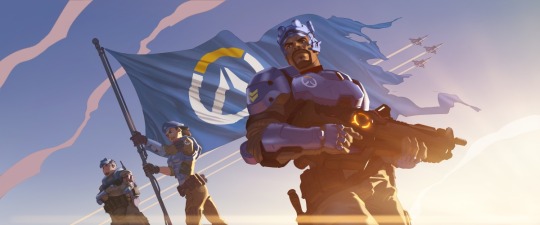
Morrison and his peers ushered in an unprecedented era of peace and prosperity, but it was not to last. Two decades after Overwatch ended the Omnic Crisis and saved humanity, it was brought to its knees by a series of shocking allegations: negligence resulting in high-profile mission failures; corruption and mismanagement; weapons proliferation; human rights abuses; and more.
A special UN committee launched a lengthy and highly secretive investigation into the claims. This inquiry would lead to the dismantling of Overwatch, and its once-beloved agents would become objects of derision and suspicion in the media. But before all of that could happen, another tragedy would rock Overwatch and serve as the troubled organization's death rattle.
As the UN investigation proceeded, Overwatch's Swiss headquarters was destroyed in an apparent accident. Among the casualties were Morrison and Reyes. The UN has steadfastly maintained that there was no foul play behind this event. However, an anonymous source has given me access to classified UN debriefings and other data that paint a different picture of Overwatch's final days.
"After Morrison's promotion to strike commander, his relationship with Reyes changed. The tension became more pronounced as time went on. I tried to mend things. We all did. Sometimes when the closest bonds break, all you can do is pray you stay out of the cross fire."
These records indicate that a rebellion tore the group apart from within. On one side was Morrison, determined to hold together what remained of Overwatch. On the other side was Reyes, whose agenda remains unknown to this day. A battle raged between these men deep within Overwatch's base. At some point, their fighting triggered an explosion that destroyed the facility and sent the dreams of an entire generation up in flames.
According to Overwatch's former agents, this outcome was inevitable. "After Morrison's promotion to strike commander, his relationship with Reyes changed," Dr. Angela Ziegler, medical director of Overwatch, stated during a UN committee hearing. "The tension became more pronounced as time went on. I tried to mend things. We all did. Sometimes when the closest bonds break, all you can do is pray you stay out of the cross fire."
The UN data goes on to disclose something even more disturbing: Morrison's body was never recovered.
This revelation could explain a recent string of high-profile robberies and attacks that have dominated the news. A masked vigilante whom authorities have named "Soldier: 76" is considered the prime suspect in these incidents. In addition to bombing corporate offices and financial institutions in the United States, this individual has breached a number of former Overwatch bases. Soldier: 76 has stolen valuable technologies from these sites, including experimental weaponry, causing untold damages in the process.
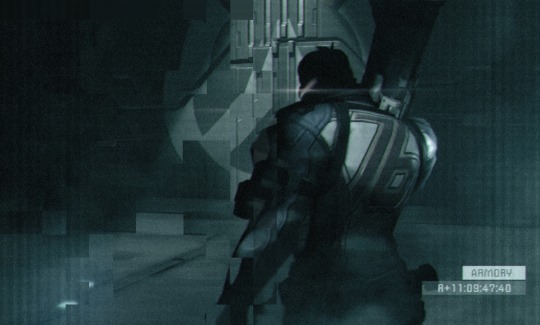
I've heard my share of theories that Soldier: 76 is Jack Morrison—theories I once would have discounted as fiction. But based on everything I've seen, I now believe these claims are true.
UN officials have declined to comment on Soldier: 76's identity. However, security personnel who were present at the former Overwatch base break-ins described the attacker as someone well versed in covert ops tactics. Surveillance footage of Soldier: 76 shows him performing superhuman feats of strength and endurance. At my request, noted forensic expert Amir Nejad, PhD, analyzed this footage. He determined that Soldier: 76 is precisely the same height and build that Morrison was in his last public appearance.
If Soldier: 76 is indeed Morrison, what is he doing, and why?
The veracity of the allegations leveled against Overwatch years ago remains a point of contention. Some historians and political pundits have questioned the motivations of those who first made the corruption charges against the group. Is Soldier: 76 on a mission to avenge the fall of Overwatch and restore its name? Is he trying to uncover a vast conspiracy that discredited and destroyed Overwatch? Or is he simply a bitter old soldier, clinging to lost glory and fighting a phantom war that he believes is still raging?
Even I, a child of the Overwatch Generation, know that the more altruistic of these scenarios are the stuff of fantasy. Soldier: 76's reckless activities, his willingness to put the lives of innocents at risk, prove that he is not driven by noble intentions. He is just a man acting in his own interests, another villain in league with the despots and international crime lords who terrorize our communities on a daily basis.
Standing before Jack Morrison's grave in Arlington National Cemetery, I'm reminded of rural Indiana's quiet serenity. Like the sea of cornstalks, neat rows of ivory tombstones seem to go on forever in all directions.
In this place of reflection and bittersweet remembrance, I realize all the more that Soldier: 76 is not the Jack Morrison I knew from my childhood. The Morrison I knew wouldn't hide behind a mask. He wouldn't plant bombs and steal weapons while the world suffered through another year of war and heartache.
That Morrison was buried here six years ago. All that's left is the shadow of the hero we once knew.
#source: news.blizzard#jack morrison#overwatch#atlas news#olympia shaw#gabriel reyes#reinhardt wilhelm#gabrielle adawe#united nations#first omnic crisis#angela ziegler#amir nejad
8 notes
·
View notes
Text
Title: India's Top 10 Architects Who Are Shaping the Future of Design
Designing useful structures is only one aspect of architecture; it is also a creative effort with the potential to influence our surroundings and way of life. A new generation of architects has developed in India, a nation rich with culture and history, pushing the frontiers of design and innovation. This article examines the top ten Indian architects who have revolutionized how we see space and made a lasting impression on the field of architecture.
Anoop Bartaria:
Anoop Bartaria is a renowned architect in India who is known for his creative and environmentally friendly approaches to design. Bartaria has made important contributions to the world of architecture with a strong dedication to contextual and environmentally sustainable design. His work effortlessly combines traditional and modern architectural elements to create spaces that are a reflection of the environment and local culture.
In Bartaria's designs, usability, environmental sensitivity, and utility are frequently given first priority. He has an in-depth understanding of building materials and methods, which he uses to make structures that not only stand out visually but also accomplish their goals.
Bimal Patel:
Bimal Patel is known for his expertise in urban planning and design. He has been instrumental in transforming the cityscape of Ahmedabad through innovative urban development projects. His visionary approach to urban design has led to the creation of vibrant and functional spaces that enhance the quality of life for residents.
Hafeez Contractor:
A stalwart in the Indian architectural scene, Hafeez Contractor's portfolio boasts a wide range of projects, from commercial towers to residential complexes. His design philosophy emphasizes functionality and practicality while maintaining an aesthetic appeal. His iconic works have significantly contributed to the modernization of India's architectural landscape.
Brinda Somaya:
Brinda Somaya is renowned for her dedication to preserving India's architectural heritage. She combines traditional craftsmanship with contemporary design, revitalizing historical structures for modern use. Her restoration projects breathe new life into forgotten gems, ensuring they remain a part of India's cultural narrative.
Raj Rewal:
Raj Rewal's architectural style is characterized by a blend of modernism and Indian architectural traditions. His designs often incorporate innovative use of space and light, resulting in structures that are not only functional but also visually striking. Rewal's iconic buildings have become landmarks in various cities across India.
B V Doshi:
A pioneer in sustainable architecture, Balkrishna Doshi's work is deeply rooted in Indian culture and climate. His designs prioritize environmental sensitivity and human well-being. Doshi's commitment to creating architecture that connects with people's emotions and the natural world has earned him international recognition, including the prestigious Pritzker Architecture Prize.
Charles Mark Correa:
Though no longer with us, Charles Correa's legacy continues to shape India's architectural discourse. His designs seamlessly merge traditional Indian architectural elements with modern sensibilities. Correa's emphasis on climate-responsive design and his advocacy for urban planning that considers the needs of all socio-economic strata have left an enduring impact.
Sameep Padora:
Sameep Padora is known for his experimental approach to architecture, often challenging conventional design norms. His projects explore new materials, construction techniques, and spatial arrangements, resulting in thought-provoking structures that redefine architectural boundaries.
Rahul Mehrotra:
Rahul Mehrotra's architectural practice extends beyond designing buildings; it encompasses urban planning, conservation, and academia. His projects often address the complex urban challenges of India, emphasizing the importance of sustainable and inclusive design solutions.
Rajiv Saini:
Rajiv Saini's minimalist and contemporary designs focus on functionality and simplicity. His attention to detail and keen understanding of materials result in spaces that are both elegant and functional, reflecting a modern Indian aesthetic.
Conclusion:
These top 10 architects in India have not only contributed to the physical landscape of the country but have also shaped the way we interact with our surroundings. Their innovative designs, commitment to sustainability, and preservation of cultural heritage have set new benchmarks for the field of architecture. As India continues to evolve, these architects will undoubtedly play a pivotal role in shaping the nation's built environment for years to come.
2 notes
·
View notes
Text
As a fan of horror who is also an absolute wuss when it comes to actually consuming horror, I am so fucking stoked Horikoshi implemented a fuck load of horror imagery and theming with Dabi and his whole story. The Frankenstein resemblance has been mentioned everywhere already so I won't touch on that but be sure I love that too.
With just his looks there's so much. The burnt purple skin. The staples covering him and looking to be holding him together, made even better and gruesome with Horikoshi's detailed artwork. His black clothing and ripped jacket that also has staples on them(gotta follow that theme). The bright blue eyes that you just know would appear to glow in his eyes sockets when framed by the purple scarring under them, like permanent eyebags. That his whole lower jaw is scarred and stapled so you can almost see Dabi unhinging his jaw in your mind. In Japan there's a supernatural creature called Onibi, spirits born from the corpses of humans and animals who take the form of blue fire. Are often also resentful spirits. Blue fire in general seems to be associate with the supernatural and the dead there(anyone who knows more feel free to correct me or add onto that tho).
But even beyond his design, his whole backstory and character is jam-packed with horror imagery. The Todoroki's being the most traditionally japanese in the whole series adds even more(seriously Japan has such amasing horror stories, whether it's movies or games or books, if you're interested pls try and check some stuff out).
Died as a young child, and kids in horror movies are both infamous and a staple, especially when they're wearing white. Touya died wearing his white track suit. His new costume is based on japanese burial clothing. Touya burned to death alone on a mountain, a cremation of his own making. No corpse was ever found except part of his jaw. The horror stories writes itself with just that, like you cannot tell me there's not an urban legend based on Touya's death on that mountain in-universe. Is the ghost of a child said to forever wander the mountain, searching for his lost jaw, or waiting for someone to finally join him in his solitude?
But then he didn't actually die. He was brought to a facility that was actually a front for human experimentation and also works as a supply of spare children in case the plans of the man behind all this don't work out with the child he has already taken. Touya wakes up to find out his body is unfamiliar to him. Three years has passed him by. His body was so far gone parts from other people had to be supplied. Normal in the case of skin grafts, but what else needed to be switched out? And either way Touya was operated on without his knowledge and then watched over and taken care of by people he does not know. And when he wakes up no one refers to him by name and he's told he can't go home.
But he does. And finds a shrine dedicated to him, his existence forgotten and left behind, and the rage and grief this spikes in him is enough for a new entity to be born. Something dark and twisted but stronger than Touya. Someone who can take revenge for the life that was lost in such a cruel way. No one else will, so Touya, Dabi, has to do it himself.
Always the ghost of the Todoroki family, there for others to simper by his shrine and use his memory in any way they please to fit them.
In reality he's been a vengeful spirit for years, finally taking his control and agency back. The sacrifice come back to life to take revenge on those who wronged him. The ghost that escaped the house.
#bnha#dabi#horikoshi really went ahead and decided “I'm going to create a character with so many horror vibes and theming”#and created one of the most unique character designs ever#i just love his design so much and having all of *waves upwards* that#makes it even better i just love dabi so much
13 notes
·
View notes